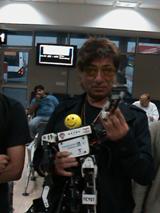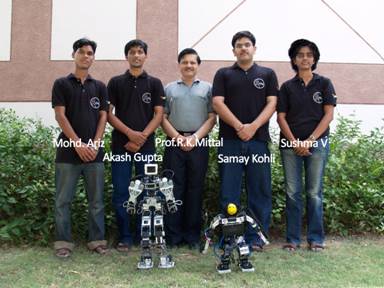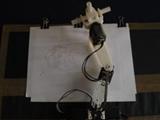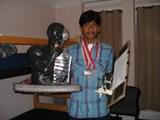Cover Story
AcYut - India's First Humanoid
 Students of BITS-Pilani have developed India's first humanoid, AcYut, which has earned international fame after winning the bronze medal at the RoboGames 2009, held in San Francisco, USA. Our Sandpaper team finds out.
Students of BITS-Pilani have developed India's first humanoid, AcYut, which has earned international fame after winning the bronze medal at the RoboGames 2009, held in San Francisco, USA. Our Sandpaper team finds out.
Soumya Sen, 2001A8PS263
Download pdf


Team Acyut in Tricolor at Robogames 2009
Students of BITS-Pilani have developed India's first humanoid, AcYut, which has earned international fame after winning the bronze medal at the RoboGames 2009, held in San Francisco, USA. With this achievement, India is now poised to become a key player in the field of robotics. Our Sandpaper team finds out what motivated these bright students and how their contribution will impact the future of robotics technology in India.
Nothing can stop an idea whose time has come*
*Victor Hugo (Histoire d'un Crime; written 1852, published 1877)
The last decade has witnessed an extraordinary progress in India's nuclear and space programs, the success of which have established her as a major player in scientific and technological research.
Sandpaper: Did you have the required lab infrastructure at BITS-Pilani?
Team AcYut: BITS actually was very forward thinking in this aspect for having set up a Robotics Lab such a long time back before many other colleges & universities in India. We were also very lucky to have excellent facilities like CNC Mill at the Flexible Manufacturing Systems Lab (FMS).
This might have led many to assume that it was only a matter of time that India ventured into the field of Robotics as well. However, research in Robotics never gathered much momentum in India and it remained as an esoteric subject of purely theoretical interest. But a group of students at BITS-Pilani were determined to change that notion for ever. They realized that the time had come to develop India's first humanoid robot that would capture the world's imagination. The fruit of their tireless efforts was the humanoid named ‘AcYut-II’ (The Imperishable). It was presented at the RoboGames 2009, the World’s Largest Robot Competition, held in San Francisco, USA by a team of four BITSians- Samay Kohli (team leader), Sushma Vallabhaneni, Mohammad Ariz and Akash Gupta- who had worked under the guidance of Professor R.K.Mittal at the Center for Robotics Intelligent Systems (CRIS) in Pilani. This indigenously developed humanoid marks the beginning of a new chapter in India's technological development and is poised to make her a key player in the field of robotics alongside other Asian countries like China and Japan.
An Unusual Visitor on Campus
Sandpaper: What motivated you to start this project?
Team AcYut: Our initial motivation was to build something that everyone in India thought was “too tough”."
In February 2007, the “International Conference of Emerging Mechanical Technology-Macro to Nano" held at BITS Pilani campus was attended by Professor Prahlad Vadakkepat of National University of Singapore. He brought with him an unusual guest -a humanoid robot named GINUS. Samay and his friends, who later became his team members, were surprised to learn that the humanoid was developed by an undergraduate student in less than eight months time. Till then, like most of us, they too had believed “that making humanoids was only possible if you invest millions of dollars in the research, and that the only humanoid out there was ASIMO by Honda.” Inspired by GINUS, the team decided to create India's first humanoid.

AcYut-I @ APOGEE’08

Team AcYut originally consisted of Samay Kohli, Arpit Mohan, Harsh Sinha, Prayag Mukherjee and Sushma Vallabhaneni. They started by creating a biped to test their technical capability. The biped, made mostly out of aluminum and motors, was a success; it could walk and kick. It served as an initial exercise that taught them valuable lessons before undertaking the bigger task of creating the full-fledged humanoid that they intended to develop for RoboGames, 2008. With the help of Prof. Raj Singh (BITSian batch of ’76) of CEERI, Pilani and BITS alumni from ’76 batch, the team secured the funding for their project. The team worked at the CRIS (Centre for Robotics and Intelligent Systems) lab which provided them with an excellent infrastructure for this project.
By March 2008, the team had prepared the first prototype of the humanoid, Acyut-I, and unveiled it in front of the curious eyes of fellow students at the annual tech-fest, APOGEE'08. This humanoid could walk, climb stairs, dance and play soccer. AcYut-I was then presented at the RoboGames 2008 in San Francisco where it won the sixth place among the 28 participating countries.
Buoyed by this success, Team Acyut went on to develop even a better version of their humanoid. In doing so, the team first analyzed the drawbacks of AcYut-I's design; for example, they found that the location of the batteries in the front part of the chest was making it difficult for the robot to maintain its balance while walking. Hence the batteries of AcYut-II were placed in the chest in a way that ensured that the center of gravity was near the centre of the robot. Furthermore, the chest and the shoulder parts were separated to ensure that the motor rotated only the necessary parts so as to not topple it whenever its arms were rotated.

Dance Lessons form
from Shakti Kapoor
The team then focused on adding Artificial Intelligence to the robot in order to make it autonomous rather than automated. The students developed a bodysuit which allows AcYut-II to mimic their own movements and actions, thus enabling them to control the robot from a distance. Therefore the robot can perform several complex moves as opposed to being restricted to a limited set of pre-programmed movements that hand-held remote controls typically allow. As a result, AcYut-II resembles humans more closely than its predecessors. AcYut-II is also taller and has a higher torque motor that gives it the strength to punch harder. Moreover, its ability to move quickly around corners reduces its chances of falling out of the ring during a Kung Fu match. These features have ensured that AcYut-II will remain true to its name.
The Chronicle of a Victory Foretold
Like its predecessor, AcYut-II was also presented in June at the RoboGames 2009 held in San Francisco, California. This humanoid was far superior to many other robots, and hence its success was inevitable. The team members informed, “Even the people who were winning medals for the last seven-eight years got scared looking at AcYut II in the rehearsals. They tried to analyze AcYut-II's moves and prepared counter moves for them during the night. Those people are generally prepared much before hand and never change their moves/strategies at the last moment. But AcYut II frightened the previous world champions also.”
Sandpaper: Did you meet your expectation with AcYut-II?
Team AcYut: As far as the design of AcYut-II is concerned, it is one of the best humanoid designs in the world, but there is always scope for improvement. With AcYut-II we have definitely reached near our expectations but there is still so much to achieve.

AcYut-II's performance won it the bronze at the RoboGames 2009 and earned it praise among the researchers, including the founder of RoboGames, Mr. David Calkins. In fact, the team felt that AcYut-II could have performed even better at the competition. “Although we were capable enough to get gold in RoboGames 2009, unfortunately, we had to forfeit the final match because of a technical glitch. Even if we had fought the match, we would have got the Silver [medal]”, the team told us.
Over the years, the project 'AcYut' has also received continuous encouragement and generous funding from the BITS Alumni Association (BITSAA), especially from ’76-’81 alumni and BITSAA-SVC. Subodh Karnik, a BITSian from ’76 batch and CEO of ATA at the time, arranged for Continental Airlines to provide Team AcYut with four tickets for the price of just one. AcYut also received sponsorship from companies like Force10Networks, Sierra Atlantic, Oriental Insurance and Continental Airlines.
The Three Musketeers
Besides the humanoid, AcYut-II, BITSians have also created three other robots which have won international praise. At the RoboGames 2009, another BITSian team, 'Automized Minds', consisting of Ravi Sankar Ippili, Uttam Grandhi and V.K. Pannala, who worked with Professor B.K.Rout, presented the three robots- Michelangelo, Cyborg and Wall-E.

Michelangelo, a robot that can sketch portraits of people when provided with the drawings of the image in Portable Grey Map Format, won the Silver Medal, while Cyborg, won the Bronze. Cyborg is a sculpture that depicts a half human and a half robot. The robot presents itself in a pensive mood, as if musing about the possible impact of the human to robot transformation on the various spheres of life. The entire structure is made out of sheet metal and thermocol. The Third robot is one that resembles the animated character, Wall-E, and it can dance to the tune of the Academy Award winning composition, “Jai Ho!”. It clinched the first prize at IIT Bombay’s TechFest held during January of 2009.
The Way Ahead and Beyond...
Team AcYut has already started their work on improving AcYut-II for RoboGames 2010. Besides using more sophisticated algorithms to ensure that AcYut will never lose its balance, the team is also focusing on the additional feature of a ‘Slave Suit’ which a human operator can wear to control the humanoid. They have completed the first build and intend to test it on visitors at the Ideen Expo at Germany in September. If this is successfully completed, such capabilities will allow the humanoid to be used in assisting police and military operations in hazardous environments.
Sandpaper: What lessons does the success story of AcYut-II teach regarding the future of Robotics in India?
Team AcYut: Indians can also compete with the Japanese and Americans in the field of Robotics which is considered to be their area of expertise as of now.
The team members are very hopeful about the future of Robotics research in India. During their travels to IIT campuses and schools across India, they have witnesses a huge interest in Robotics among undergraduate students. When asked about their future plans, the enthusiastic response from Team AcYut was: “We plan to start up a company that offers Robotics education in a completely different and fun way.”


The BITSian Alumni are also equally excited about the prospects of Robotics in India. Raju Reddy, CEO of Sierra Atlantic, told us “While we have plenty to cheer about the success of our ACYUT team, what excites me most is the opportunity now for BITS Pilani to become the hub of Robotics studies and research in India and one of the leading centers for Robotics in Asia over time. Accomplishing this goal in the long term will be the greatest reward my class of ’76-’81 can have for volunteering their time, money and ideas to this initiative. Robotics by nature is also multi-disciplinary – Electrical Engineering, Mechanical Engineering and Computer Science (not counting Art) making it particularly attractive for a premier University like BITS to focus on for building leadership”.
What is the selection process for Team AcYut?
It starts with a demonstration and open interaction along with a written resume. Those who are short-listed are taken on probation to assess their commitment and only then are they taken in.
Viggy Mokkarala, another alumni from ’76 batch who played an important role in raising funds and publicity for the team told us, “ACYUT-II’s is success in RoboGames 2009 and the ensuing worldwide publicity has put BITS on the map as THE center for Robotics in India. The team's travels around the country and the interest generated are proof of this”.
Sandpaper: Has the Government of India shown any interest in this development so far?
Prof. R. K. Mittal: The Atomic Energy Agencies were very interested in AcYut as they see a future in using robots to replace humans in hazardous environments. Commercial agencies are also interested in it as a programmable platform for humanoid robotics development.
Prof. R.K. Mittal told the Sandpaper Team that he needed only two words to describe the future of Robotics at BITS- “Very Bright!” He added that the team is now working towards developments in the field of Micro-robotics. “We will soon be setting up a MEMS design centre. 70 lakh rupees have already been sanctioned for this lab. The fabrication of all component designs will be done at CEERI.” he informed us. The creation of AcYut-II at BITS has brought hope for a new technological revolution in India. As BITSians we all share the joy and wish Team AcYut even greater success in all their future efforts.


